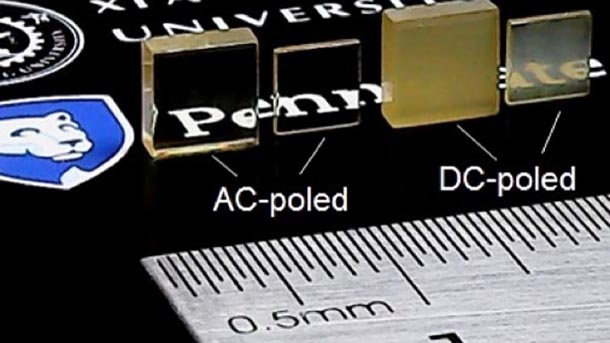
Transparent crystal of piezoelectric material comparing crystals that were treated with AC or DC electric fields. IMAGE: BO WANG/PENN STATE
Transparency discovered in crystals with ultrahigh piezoelectricity
1/20/2020
By A’ndrea Elyse Messer
UNIVERSITY PARK, Pa. — Use of an AC rather than a DC electric field can improve the piezoelectric response of a crystal. Now, an international team of researchers say that cycles of AC fields also make the internal crystal domains in some materials bigger and the crystal transparent.
“There have been reports that the use of AC fields could significantly improve the piezoelectric responses — for example by 20% to 40% — over DC fields and the improvements have always been attributed to the smaller internal ferroelectric domain sizes that resulted from the cycles of AC fields,” said Long-Qing Chen, Hamer Professor of Materials Science and Engineering, professor of engineering science and mechanics, and professor of mathematics at Penn State. “About three years ago, Dr. Fei Li, then a research associate at the Materials Research Institute at Penn State, largely confirmed the improvement of piezoelectric performances from application of AC fields. However, it was not clear at all how the internal ferroelectric domains evolved during AC cycles.
“Our group does mostly computer modeling, and more than a year ago we started looking into what happens to the internal domain structures if we apply AC fields to a ferroelectric piezoelectric crystal. We are very curious about how the domain structures evolve during AC cycles. Our computer simulations and theoretical calculations did show an improved piezoelectric response, but our simulations also demonstrated that the ferroelectric domain sizes actually got bigger during AC cycles rather than smaller as reported in the literature.”
Piezoelectric materials generate electric charges when a mechanical force is applied and deform or change shape when an electric field is applied. The researchers investigated lead magnesium niobate-lead titanate — PMN-PT — a commercially available piezoelectric material. The computational results were unexpected because most people in the piezoelectric community believe that the smaller the domains are, the higher the piezoelectric response.
Domains within a crystal are areas within which the electric dipoles or electric polarization arrange themselves along the same direction. Before the alignment of dipoles or polarization of a PMN-PT crystal using an electric field, there are many tiny domains with polarization along different directions. As cycles of AC electric fields are applied to the crystal, the domains realign, becoming fewer and larger. After several AC cycles, the domains are large and in layers.
“The simulation results were in contradiction to reports in the literature,” said Chen. “We needed to dig deeper to see if reality agrees with our simulation results.”
Researchers at Xi’an Jiaotong University in China then grew their own PMN-PT crystals and carefully examined the domain configurations within their samples using various experimental characterization techniques under different AC cycling conditions. They confirmed the computational predictions from Penn State that domains actually become larger during AC cycles.
The larger domain size and the particular layer domain structures also suggest that a ray of light shown onto the crystal would be unimpeded and shine right through — the crystal would be transparent. The crystals not only possess ultrahigh piezoelectricity, but also are highly transparent after their surfaces are carefully polished. In the past, crystals like this have always been opaque.
The researchers report today (Jan. 15) in Nature that “the work presents a paradigm to achieve an unprecedented combination of properties and functionalities through ferroelectric domain engineering, and the new transparent ferroelectric crystals reported here are expected to open up a wide range of hybrid device applications, such as medical imaging, self-energy-harvesting touch screens and invisible robotic devices.”
Others working on this project from Penn State are Bo Wang, graduate student in materials science and engineering, and Thomas Shrout, emeritus professor and senior scientist in materials science and engineering.
Researchers from other institutions include Shujun Zhang, a professor of materials science formerly at Penn State and now at the University of Wollongong in Australia; Chaorui Qiu, Nan Zhang, Jinfeng Liu, Zhuo Xu and Fei Li, all of the Electronic Materials Research Lab at Xi’an Jiaotong University in China; David Walker in the Department of Physics at the University of Warwick in the U.K.; and Yu Wang and Hao Tan, both in the School of Physics at the Harbin Institute of Technology in China.
The researchers from Penn State and Xi’an Jiaotong University have jointly filed for a U.S. patent on this work.
The National Natural Science Foundation of China, the U.S. National Science Foundation, and the U.S. National Science Foundation Materials Research Science and Engineering Center supported this work. The computer simulations were performed at the Pittsburgh Supercomputing Center.



